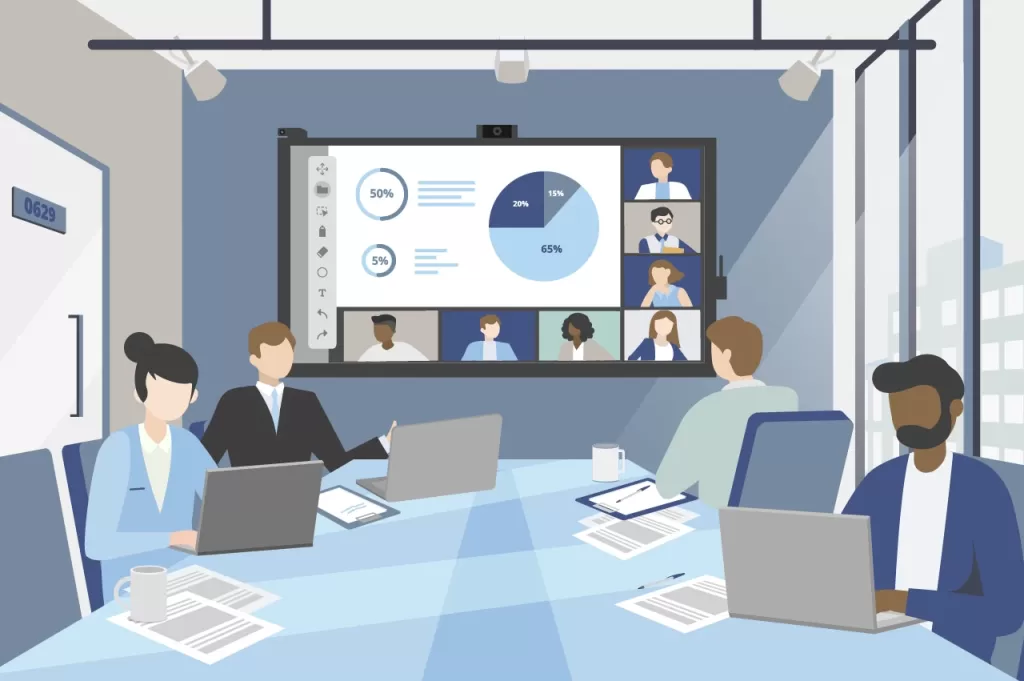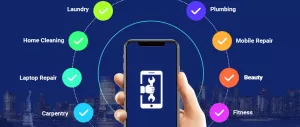Written By:
Scott McAuley
Scott is the IT Director of Texas Management Group, and has been in the IT industry for 25 years.
Video conferencing has become a cornerstone of modern communication, and it’s only set to grow more powerful by 2025.
With advancements in technology, virtual meetings are becoming more seamless, immersive, and efficient, reshaping how businesses and individuals connect across the globe. But what does the future hold for video conferencing?
From AI integration to enhanced collaboration tools, the way we conduct remote meetings is evolving rapidly. Understanding these key insights will help you stay ahead and make the most of what’s to come.
Curious about what’s next for video conferencing? Let’s dive into the future of this game-changing technology and uncover what’s in store for 2025!
Key Takeaways:
- Video conferencing is evolving rapidly, with AI integration and enhanced collaboration tools boosting efficiency and immersive experiences.
- The rise of video conferencing post-COVID has reshaped remote work, education, and personal interactions across the globe.
- Telepresence systems offer realistic, immersive experiences, making them ideal for high-stakes meetings and critical presentations.
- Video conferencing improves global connectivity, bridging distances and enabling real-time communication, regardless of location or time zone.
- Key benefits include increased productivity, cost savings, flexibility, enhanced communication, and overcoming geographical barriers for global collaboration.
Table of Contents
What is Video Conferencing?

Video conferencing connects people from different locations in real-time. Using the internet, along with specific software or hardware, it enables virtual meetings and collaborations.
It recreates the experience of being in the same room by allowing participants to see and hear each other. For businesses, schools, and remote teams, this has revolutionized the way we communicate across distances.
To function smoothly, video conferencing requires reliable cameras, microphones, and speakers. A strong internet connection is also essential to ensure seamless video and audio quality.
Traditional Conference vs. Video Conference
When deciding between a traditional conference and a video conference, it’s essential to understand the key differences.
Let’s break down how these two methods compare in terms of convenience, cost, and overall experience:
| Aspect | Traditional Conference | Video Conference |
|---|---|---|
| Location | Requires physical presence in a set location. | Can be conducted from anywhere with an internet connection. |
| Travel | Involves travel time and expenses. | Eliminates the need for travel, saving time and money. |
| Cost | High costs for venue, travel, accommodation, etc. | Significantly lower costs, with no travel or venue expenses. |
| Setup | Requires organizing physical spaces and equipment. | Only needs a stable internet connection and devices. |
| Participant Reach | Limited to those who can physically attend. | Can include participants from any location worldwide. |
| Flexibility | Harder to reschedule due to logistics. | Easier to schedule and reschedule with minimal effort. |
| Interaction | Face-to-face, in-person networking and discussions. | Face-to-face virtually, with interactive features like chat and screen sharing. |
| Environmental Impact | Higher carbon footprint due to travel and materials. | Lower environmental impact with reduced travel and resources. |
| Time Efficiency | Time-consuming with travel and setup delays. | Instant, real-time meetings with minimal delay. |
The Rise of Video Conferencing After COVID
The COVID-19 pandemic changed how we work and learn overnight. Social distancing made video conferencing essential for both companies and schools.
Before the pandemic, video calls were mostly used by big businesses and tech-savvy individuals. COVID-19 forced everyone to adopt virtual meetings quickly, keeping operations going remotely.
Education also had to adapt. Schools around the world moved online, with teachers using video calls to continue classes from home.
Video conferencing replaced in-person events for personal connections as well. Birthdays, weddings, and casual meet-ups all shifted to virtual spaces, keeping relationships strong despite the distance.
Looking ahead, video conferencing will likely continue growing. Hybrid work models, mixing remote work with team gatherings, are becoming the new norm.
How Does Video Conferencing Work?
Video conferencing allows people to communicate in real-time from different locations. It relies on the internet to transmit audio and video between participants.
Here’s how video conferencing works:
- To use video conferencing, you need a device with a camera, microphone, and speakers. Most modern laptops and smartphones come equipped with these, making it easy to join calls.
- Participants connect through a video conferencing platform like Zoom, Microsoft Teams, or Google Meet. These platforms handle the transmission of both video and audio data.
- A strong internet connection is necessary for smooth, high-quality communication. It ensures that the video and audio feeds remain clear and uninterrupted throughout the call.
- Video conferencing platforms offer additional features such as screen sharing, chat functions, and the ability to record sessions. These tools help improve collaboration by allowing participants to share information in real-time.
- Ultimately, video conferencing replicates face-to-face communication without the need for physical presence. It’s a convenient solution for business meetings, remote learning, and personal interactions.
7 Things You Need in Video Conferencing
To ensure your video conferences go smoothly, having the right tools is key. This is true whether you’re having virtual meetings, working together online, or joining video calls from afar.
We’ll dive into the must-haves for any successful video discussion:
| Aspect | Description |
|---|---|
| Camera | A high-quality webcam (720p or higher) with autofocus and good light handling. |
| Microphone | A noise-reducing mic, like a USB mic or headset, for clear audio. |
| Speakers/Headphones | Headphones with noise cancellation to eliminate echoes and focus on sound. |
| Display Monitor | A large monitor with accurate colors and wide viewing angles for clear visuals. |
| Computer or Device | A device capable of handling audio/video smoothly with a strong internet setup. |
| Video Conferencing App | Reliable platforms like Zoom, Teams, or Meet for seamless online meetings. |
| Internet Connection | A stable, strong broadband connection for uninterrupted video and audio quality. |
1. Camera
For video calls that are crystal clear, a top-notch camera is essential. Opt for a webcam that’s 720p or above for sharp images. Ensure it has autofocus and can handle different light settings for the best visuals.
2. Microphone
High-quality audio is just as vital as good video. A microphone that’s good at picking up your voice without the noise around you is crucial. For the best sound, consider using a headset or a dedicated USB mic.
3. Speakers/Headphones
To understand others clearly, having good speakers or headphones is a must. Headphones are often recommended since they cut out echo and focus the audio on you. If you go for headphones, choose ones with noise-cancelling to cut down background noise.
4. Display Monitor
A top-tier monitor kicks the visual aspect of your video conferences up a notch. Look for one that’s big enough and provides accurate colors. Also, check its viewing angles to ensure everyone on your end looks good.
5. Computer or Mobile Device
Your computer or mobile device should be up to snuff for video calls. It needs to handle the audio and video requirements without a hitch. Make sure it matches your conferencing platform’s needs and has a reliable internet connection.
6. Video Conferencing Platforms
Finding the right video conferencing app is crucial for effective online meetings. TEXMG, Zoom, Microsoft Teams, Google Meet, and Cisco Webex are some popular choices. Pick one that fits your needs, and works well with your current tools.
7. Internet Connection
Don’t forget a stable internet connection for successful video calling. A strong broadband is a must for clear video and audio. Wired connections are often more dependable, but if you use Wi-Fi, be sure it’s strong and free from interference.
6 Types of Video Conferencing Systems
In the fast-paced business world, video conferencing is crucial for remote meetings and online communication. Technology has brought many video conferencing systems to the market, each meeting different needs.
Let’s look at the six main types, changing how we interact and work together:
| Video Conferencing System | Key Features | Ideal Use Cases |
|---|---|---|
| Telepresence | Immersive experience, high-definition audio and video, multiple camera angles | Important meetings, negotiations, presentations |
| Integrated | Combined hardware and software components, user-friendly | Regular video calls, remote meetings |
| Service-Based | Hosted and managed by providers, scalable, flexible, accessible | Small and medium-sized businesses, remote teams |
| Codec | Specialized hardware devices, high-quality audio and video | Large conference rooms, auditoriums |
| Desktop | Software-based, runs on personal devices, leverages built-in components | Individual users, small teams, remote workers |
| Room-Based | Designed for conference rooms, high-quality audiovisual equipment | Group video calls, presentations, collaborative meetings |
1. Telepresence Video Conferencing Systems
Telepresence systems offer an extremely realistic experience. Participants feel like they’re in the same room.
They use top-notch audio, video, and various views to create an immersive digital space. These are great for critical meetings and presentations when being there truly matters.
2. Integrated Video Conferencing Systems
Integrated systems blend both hardware and software, offering all-in-one solutions. They come with necessary components like cameras and a platform for smooth video communication.
They target organizations needing an easy and reliable option for their virtual meetings.
3. Service-Based Video Conferencing Systems
Service-based systems are run by outside providers. This means companies don’t have to worry about their own system maintenance.
Any devices with internet access can be used for video calls. They are favored by those that prefer not to deal with IT tasks.
4. Codec Video Conferencing Systems
Codec systems use a special hardware to compress audio and video for online transmission. They provide high-quality visual and audio.
Perfect for large spaces, these systems can work with a variety of multimedia devices. This complements a professional approach to video meetings.
5. Desktop Video Conferencing Systems
Desktop systems are all about the software and run on your personal devices. They integrate with the tools already in your device, from cameras to microphones.
They’re great for single users or small teams working from various locations.
6. Room-Based Video Conferencing Systems
Specifically for conference rooms, these systems have top-notch cameras, mics, and displays. They’re ideal for larger meetings with more than one participant on each end.
Such setups are typical for companies often hosting group video conferences.
Best Applications of Video Conferencing
Video conferencing has revolutionized communication, making it more efficient and accessible. It plays a key role in various industries, from work and education to client interactions and recruitment.
Let’s explore the best real-life applications of video conferencing:
| Application | Key Benefits |
|---|---|
| Remote Work and Telecommuting | Flexibility, increased productivity, cost savings |
| Online Education and Training | Accessibility, interactive learning, global reach |
| Client Meetings and Sales Presentations | Time and cost savings, wider audience reach, engaging presentations |
| Recruitment and Job Interviews | Streamlined hiring process, cost-effectiveness, broader talent pool |
| Team Collaboration and Project Management | Seamless collaboration, efficient decision-making, project alignment |
| Customer Support and Service | Enhanced customer experience, personalized assistance, stronger relationships |
| Event Hosting and Conferences | Global reach, inclusivity, cost-effectiveness, virtual networking |
Remote Work and Telecommuting
Video conferencing is essential for remote work and telecommuting. It enables teams to collaborate online, regardless of location, improving flexibility and productivity.
Online Education and Training
Video conferencing makes education more accessible and interactive. Teachers can deliver engaging lessons globally, allowing students to learn from anywhere, enhancing their experience.
Client Meetings and Sales Presentations
Businesses now rely on video conferencing for client meetings and sales presentations. It reduces the need for travel while expanding the reach and boosting audience engagement.
Recruitment and Job Interviews
The hiring process has become more efficient with video conferencing. Virtual interviews streamline recruitment, cutting costs and providing access to a broader talent pool.
Team Collaboration and Project Management
Video conferencing improves team collaboration and project management. Remote teams can meet, share ideas, and make decisions quickly, keeping projects aligned and on track.
Customer Support and Service
Businesses now offer customer support via video calls, providing a personal touch. This method strengthens customer relationships and enhances satisfaction through face-to-face assistance.
Event Hosting and Conferences
Event hosting is simplified with virtual conferences. Video conferencing allows for global participation, making events more inclusive, cost-effective, and easier to organize.
5 Pros of Video Conferencing
Video conferencing is transforming how we communicate, both in business and personal settings. It bridges distances using advanced web technologies, making it essential in today’s remote work environment.
Here are five major benefits of video conferencing for more effective online collaboration:
1. Enhanced Communication
Video conferencing enhances communication by creating a face-to-face experience. Participants can see facial expressions and body language, improving understanding and reducing misunderstandings.
2. Increased Productivity
With video conferencing, productivity increases by eliminating the need for travel. Virtual meetings allow teams to focus more on their goals without wasting time commuting.
3. Cost Savings
Video conferencing reduces the costs associated with physical meetings. Companies save on travel, accommodation, and venue expenses, allowing them to reallocate resources to other priorities.
4. Flexibility
This technology offers unmatched flexibility, allowing participants to join meetings from anywhere. It enables global collaboration and accommodates those with tight schedules or travel limitations.
5. Global Connectivity
Video conferencing breaks geographical barriers, enabling communication across time zones. It fosters stronger relationships, smooth project coordination, and helps businesses expand their global presence.
3 Cons of Video Conferencing
Video conferencing, despite its benefits, comes with certain challenges. These obstacles can impact the quality and effectiveness of virtual meetings.
From technical difficulties to the lack of personal connection, understanding these drawbacks helps you prepare for a smoother experience.
Here are the cons of video conferencing and ways to mitigate them:
1. Technical Issues
Technical glitches are a common frustration with video conferencing. Poor internet connection, device issues, or platform incompatibility can interrupt meetings and affect productivity.
2. Lack of Personal Connection
Building rapport through a screen is harder than in person. Video calls miss the subtle body language and informal interactions that strengthen team bonds and cooperation.
3. Security Concerns
Video conferencing presents security risks, from unauthorized access to data breaches. Implementing encryption and strict access controls is essential to protect sensitive information during virtual meetings.
Conclusion
Video conferencing is set to become even more dynamic by 2025, offering seamless connectivity, enhanced tools, and immersive experiences.
The rise of AI and improved collaboration features will transform how businesses and individuals interact across distances.
As technology continues to evolve, leveraging video conferencing effectively can boost productivity, cut costs, and improve global communication.
Ready to take your video conferencing to the next level? Explore these insights and embrace the future of virtual collaboration.
Let’s shape the future of communication together!
Interested in Boosting Your Video Conferencing Experience?
Read our blogs on best practices for virtual meetings, and find out how our Business Communication Solutions provide reliable, seamless connectivity.
Connect with confidence!
FAQ
What Do You Mean by Video Conference?
A video conference is a live, visual connection between two or more people in different locations.
What is an Example of a Video Conference?
An example is a Zoom meeting where team members collaborate remotely.
What are the Advantages of Video Conferencing?
Advantages include reduced travel costs, improved communication, and increased productivity.
What is the Meaning of Video Conferencing Brainly?
Video conferencing on Brainly allows users to have real-time discussions to share knowledge and information.






